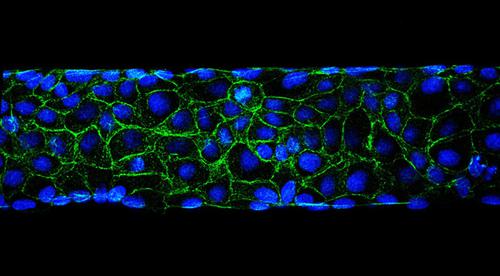当前位置:
X-MOL 学术
›
Biotechnol. Bioeng.
›
论文详情
Our official English website, www.x-mol.net, welcomes your feedback! (Note: you will need to create a separate account there.)
Engineering slit-like channels for studying the growth of epithelial tissues in 3D-confined spaces.
Biotechnology and Bioengineering ( IF 3.8 ) Pub Date : 2020-06-02 , DOI: 10.1002/bit.27446 Laura Alaimo 1 , Marine Luciano 1 , Danahe Mohammed 1 , Marie Versaevel 1 , Céline Bruyère 1 , Eléonore Vercruysse 1 , Sylvain Gabriele 1
Biotechnology and Bioengineering ( IF 3.8 ) Pub Date : 2020-06-02 , DOI: 10.1002/bit.27446 Laura Alaimo 1 , Marine Luciano 1 , Danahe Mohammed 1 , Marie Versaevel 1 , Céline Bruyère 1 , Eléonore Vercruysse 1 , Sylvain Gabriele 1
Affiliation

|
The development of epithelial lumens in ducts is essential to the functioning of various organs and in organogenesis. Ductal elongation requires the collective migration of cell cohorts in three‐dimensional (3D) confined spaces, while maintaining their epithelial integrity. Epithelial lumens generally adopt circular morphologies, however abnormalities in complex physiological environments can lead to the narrowing of glandular spaces that adopt elongated and slit‐like morphologies. Here, we describe a simple method to form epithelial tissues in microchannels of various widths (100–300 µm) with a constant height of 25 µm that mimic elongated geometries of glandular spaces. The significance of this biomimetic platform has been evidenced by studying the migration of epithelial cell sheets inside these narrow slits of varying dimensions. We show that the growth of epithelial tissues in 3D‐confined slits leads to a gradient of cell density along the slit axis and that the migration cell velocity depends on the extent of the spatial confinement. Our findings indicate that nuclear orientation is higher for leader cells and depends on the slit width, whereas YAP protein was predominantly localized in the nucleus of leader cells. This method will pave the way to studies aiming at understanding how 3D‐confined spaces, which are reminiscent of in vivo pathological conditions, can affect the growth and the homeostasis of epithelial tissues.
中文翻译:

用于研究 3D 受限空间中上皮组织生长的工程狭缝状通道。
导管中上皮腔的发育对于各种器官的功能和器官发生至关重要。导管伸长需要细胞群在三维 (3D) 密闭空间中集体迁移,同时保持其上皮完整性。上皮管腔通常采用圆形形态,但复杂生理环境中的异常会导致腺体空间变窄,呈细长和狭缝状形态。在这里,我们描述了一种简单的方法,可以在各种宽度 (100–300 µm) 的微通道中形成上皮组织,其恒定高度为 25 µm,模拟腺体空间的细长几何形状。通过研究这些不同尺寸的窄缝内的上皮细胞片的迁移,证明了这种仿生平台的重要性。我们表明,上皮组织在 3D 限制狭缝中的生长导致沿狭缝轴的细胞密度梯度,并且细胞迁移速度取决于空间限制的程度。我们的研究结果表明,前导细胞的核取向更高,取决于狭缝宽度,而 YAP 蛋白主要位于前导细胞的细胞核中。这种方法将为旨在了解 3D 受限空间如何影响上皮组织的生长和稳态的研究铺平道路,这些空间让人联想到体内病理条件。我们的研究结果表明,前导细胞的核取向更高,取决于狭缝宽度,而 YAP 蛋白主要位于前导细胞的细胞核中。这种方法将为旨在了解 3D 受限空间如何影响上皮组织的生长和稳态的研究铺平道路,这些空间让人联想到体内病理条件。我们的研究结果表明,前导细胞的核取向更高,取决于狭缝宽度,而 YAP 蛋白主要位于前导细胞的细胞核中。这种方法将为旨在了解 3D 受限空间如何影响上皮组织的生长和稳态的研究铺平道路,这些空间让人联想到体内病理条件。
更新日期:2020-06-02
中文翻译:

用于研究 3D 受限空间中上皮组织生长的工程狭缝状通道。
导管中上皮腔的发育对于各种器官的功能和器官发生至关重要。导管伸长需要细胞群在三维 (3D) 密闭空间中集体迁移,同时保持其上皮完整性。上皮管腔通常采用圆形形态,但复杂生理环境中的异常会导致腺体空间变窄,呈细长和狭缝状形态。在这里,我们描述了一种简单的方法,可以在各种宽度 (100–300 µm) 的微通道中形成上皮组织,其恒定高度为 25 µm,模拟腺体空间的细长几何形状。通过研究这些不同尺寸的窄缝内的上皮细胞片的迁移,证明了这种仿生平台的重要性。我们表明,上皮组织在 3D 限制狭缝中的生长导致沿狭缝轴的细胞密度梯度,并且细胞迁移速度取决于空间限制的程度。我们的研究结果表明,前导细胞的核取向更高,取决于狭缝宽度,而 YAP 蛋白主要位于前导细胞的细胞核中。这种方法将为旨在了解 3D 受限空间如何影响上皮组织的生长和稳态的研究铺平道路,这些空间让人联想到体内病理条件。我们的研究结果表明,前导细胞的核取向更高,取决于狭缝宽度,而 YAP 蛋白主要位于前导细胞的细胞核中。这种方法将为旨在了解 3D 受限空间如何影响上皮组织的生长和稳态的研究铺平道路,这些空间让人联想到体内病理条件。我们的研究结果表明,前导细胞的核取向更高,取决于狭缝宽度,而 YAP 蛋白主要位于前导细胞的细胞核中。这种方法将为旨在了解 3D 受限空间如何影响上皮组织的生长和稳态的研究铺平道路,这些空间让人联想到体内病理条件。



























 京公网安备 11010802027423号
京公网安备 11010802027423号